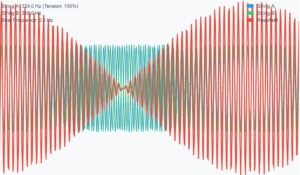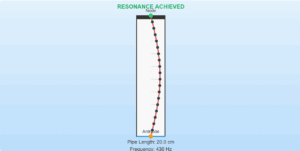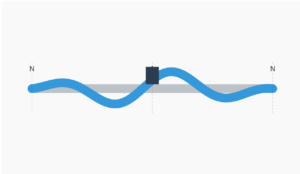Wave Superposition Simulation
Interactive Physics Demonstration - Visualize Wave Interference
Wave Visualization Canvas
Loading Wave Superposition Simulation...
Understanding the Principle of Superposition
Wave superposition occurs when two or more waves meet while traveling along the same medium. The resultant wave displacement at any point is the algebraic sum of the displacements of the individual waves. Importantly, the waves pass through each other without being permanently altered.
In this wave superposition simulation:
- The blue wave (Wave 1) travels to the right →
- The red wave (Wave 2) travels to the left ←
- The purple wave shows the superposition (sum) of both waves
Key observations:
- Constructive Interference: When both waves are in phase (0° phase difference), amplitudes add up, creating a larger wave
- Destructive Interference: When waves are out of phase (180° phase difference), they can cancel each other out
- Partial Interference: Phase differences between 0° and 180° create various interference patterns
Understanding Wave Superposition Simulation
A wave superposition simulation is an essential tool for understanding how waves interact when they meet. This principle, fundamental to physics, explains phenomena ranging from noise-canceling headphones to the behavior of light in optical systems.
What is Wave Superposition?
The principle of superposition states that when two or more waves overlap, the resulting displacement at any point is the vector sum of the displacements that would have been produced by each wave individually. This wave superposition simulation visualizes this principle in real-time.
Types of Wave Interference
This wave superposition simulation demonstrates two main types of interference:
- Constructive Interference: Occurs when waves are in phase (phase difference = 0° or 360°). The amplitudes add together, creating a wave with larger amplitude. In this simulation, set the phase difference to 0° to see maximum constructive interference.
- Destructive Interference: Occurs when waves are out of phase (phase difference = 180°). The waves cancel each other partially or completely. Set the phase difference to 180° and make amplitudes equal to see complete cancellation.
Key Parameters in Wave Superposition Simulation
Understanding these parameters helps you explore different aspects of wave superposition:
- Amplitude: The maximum displacement from equilibrium. Larger amplitude means more energy in the wave. Try adjusting Wave 1 and Wave 2 amplitudes independently.
- Wavelength (λ): The distance between consecutive crests or troughs. Shorter wavelengths mean more oscillations in a given distance.
- Phase Difference (φ): The angular difference between two waves. This determines whether interference is constructive (φ = 0°), destructive (φ = 180°), or somewhere in between.
Real-World Applications of Wave Superposition
Understanding wave superposition through simulations like this one is crucial for:
- Noise Cancellation: Headphones use destructive interference to cancel ambient noise
- Musical Instruments: Standing waves in instruments result from superposition of incident and reflected waves
- Radio Communications: Signal interference occurs when multiple radio waves superpose
- Optics: Thin-film interference in soap bubbles and oil slicks results from light wave superposition
- Seismology: Earthquake waves superpose to create complex ground motion patterns
- Quantum Mechanics: Electron wave functions superpose to create interference patterns
Mathematical Foundation
In this wave superposition simulation, the waves are described by:
- Wave 1: y₁(x,t) = A₁ sin(kx - ωt)
- Wave 2: y₂(x,t) = A₂ sin(kx + ωt + φ)
- Superposition: y(x,t) = y₁(x,t) + y₂(x,t)
Where A is amplitude, k is wave number (2π/λ), ω is angular frequency, and φ is phase difference.
Educational Benefits of Wave Superposition Simulation
This interactive wave superposition simulation provides several learning advantages:
- Visual understanding of abstract mathematical concepts
- Real-time observation of how parameter changes affect interference
- Clear demonstration of constructive and destructive interference
- Foundation for understanding more complex wave phenomena like standing waves and beats
- Intuitive grasp of phase relationships between waves
Exploring Different Scenarios
Try these experiments with the wave superposition simulation:
- Perfect Constructive Interference: Set both amplitudes to 1.0 and phase difference to 0°. Notice the purple wave has twice the amplitude.
- Perfect Destructive Interference: Set both amplitudes to 1.0 and phase difference to 180°. The purple wave flatlines (zero amplitude).
- Unequal Amplitudes: Set amplitude1 to 2.0 and amplitude2 to 1.0 with 180° phase. The waves don't cancel completely.
- Varying Wavelength: Change the wavelength to see how it affects the spatial pattern of interference.
Use this wave superposition simulation to develop a deep understanding of how waves interact and prepare for more advanced topics in wave physics, acoustics, optics, and quantum mechanics.



